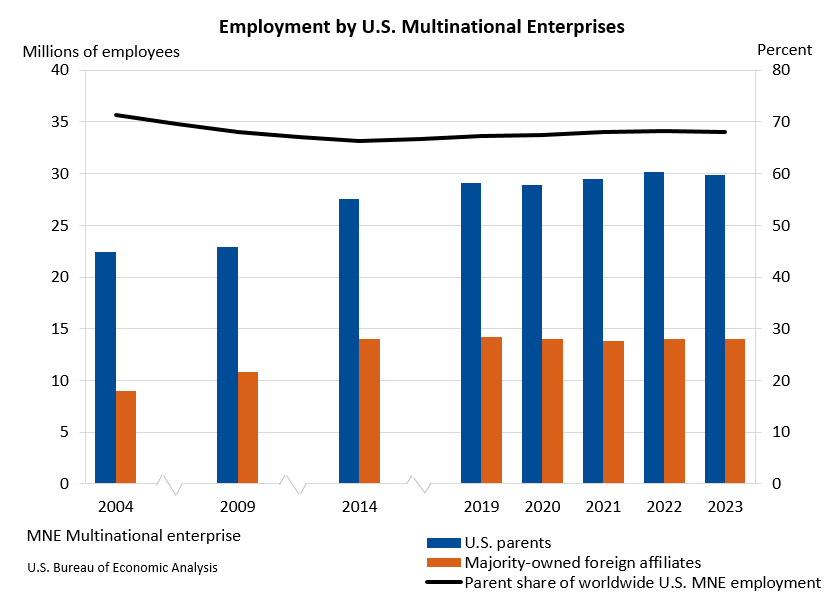Bureau of Economic Analysis
Activities of U.S. Multinational Enterprises, 2023
Worldwide employment by U.S. multinational enterprises decreased 0.4 percent to 43.9 million workers in 2023 (preliminary) from 44.1 million workers in 2022 (revised), according to statistics released today by the U.S. Bureau of Economic Analysis on the operations and finances of U.S. parent companies and their foreign affiliates.
Principal Federal Economic Indicators
Noteworthy
- 2025 News Release Schedule
- Innovation at BEA
- 2025 Annual Updates
- Distribution of Personal Income Nowcast
- New! Services Trade Data for More Countries
- Data Tool: Trade in Value Added
- Updated: RIMS II Regional Multipliers
- Arts and Culture
- Space Economy
- FDI Now in State BEARFACTS
- Quick Guide: Price Indexes
The Latest
Real Disposable Income Rises in December
Personal income increased 0.3 percent in December, the same increase as in November. Wages and salaries, the largest component of personal income, increased 0.2 percent in December after increasing 0.5 percent in November.
Personal Income and Outlays, December 2015
Personal income increased $42.5 billion, or 0.3 percent, and disposable personal income (DPI) increased $37.8 billion, or 0.3 percent, in December, according to the Bureau of Economic Analysis. Personal consumption expenditures (PCE) decreased $0.7 billion, or less than 0.1 percent.
GDP Increases in Fourth Quarter
Real gross domestic product (GDP) increased 0.7 percent in the fourth quarter of 2015, according to the “advance” estimate released by the Bureau of Economic Analysis. In the third quarter, real GDP increased 2.0 percent.
GDP highlights
Gross Domestic Product, 4th quarter and annual 2015 (advance estimate)
Real gross domestic product -- the value of the goods and services produced by the nation’s economy less the value of the goods and services used up in production, adjusted for price changes -- increased at an annual rate of 0.7 percent in the fourth quarter of 2015, according to the "advance" estimate released by the Bureau of Economic Analysis.
Industry in Focus: How Health Care and Social Assistance Fared in Third Quarter
Health care is an industry that many of us experience firsthand, whether receiving treatment for an illness or injury or simply getting an annual check-up. In the third quarter of 2015, health care and social assistance was the second-leading contributor to the 2 percent increase in the U.S. economy’s growth, providing 0.38 percentage point to real GDP.
Retail Trade Led Growth in the Third Quarter Gross Domestic Product by Industry
Retail trade; health care and social assistance; and agriculture, forestry, fishing, and hunting were the leading contributors to the increase in U.S. economic growth in the third quarter of 2015. Overall, 15 of 22 industry groups contributed to the 2.0 percent increase in real GDP in the third quarter.
Gross Domestic Product by Industry, 3rd quarter 2015
Retail trade; health care and social assistance; and agriculture, forestry, fishing, and hunting were the leading contributors to the increase in U.S. economic growth in the third quarter of 2015, according to statistics on the breakout of gross domestic product (GDP) by industry released today by the Bureau of Economic Analysis (BEA). Overall, 15 of 22 industry groups contributed to the 2.0 percent increase in real GDP in the third quarter…
Gross Domestic Product for American Samoa, 2014
This release is available as a PDF download.
American Samoa's Economy Grows in 2014
American Samoa’s economy grew 1.6 percent in 2014, the Bureau of Economic Analysis reported today.
The estimate is for real GDP, which is adjusted to remove price changes. For comparison, real GDP for the United States (excluding U.S. territories) increased 2.4 percent in 2014.
The growth in the American Samoa economy reflected widespread increases among the components of GDP. These increases were partly offset by an increase…
November 2015 Trade Gap is $42.4 Billion
The U.S. monthly international trade deficit decreased in November 2015 according to the U.S. Bureau of Economic Analysis and the U.S. Census Bureau. The deficit decreased from $44.6 billion in October (revised) to $42.4 billion in November, as exports decreased less than imports. The previously published October deficit was $43.9 billion. The goods deficit decreased $2.3 billion from October to $61.3 billion in November. The services surplus…




